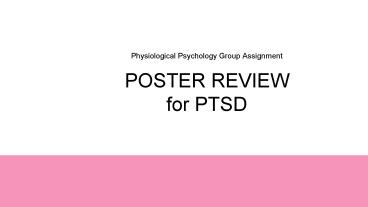Physiological Psychology - PTSD Poster Review - PowerPoint PPT Presentation
Title:
Physiological Psychology - PTSD Poster Review
Description:
Poster Review for PTSD: - Introduction (Definition, Prevalence for adults, children and veterans, the invisible PTSD) - Types of diseases and symptoms - Risk Factors - Complications - Treatment - Conclusion – PowerPoint PPT presentation
Number of Views:14
Title: Physiological Psychology - PTSD Poster Review
1
Physiological Psychology Group Assignment
POSTER REVIEW for PTSD
2
(No Transcript)
3
Content
- Introduction
- Definition
- Prevalence
- The Invisible PTSD
- Types of Disease and Symptoms
- Risk Factors
- Complications
- Treatment
4
1 - Introduction
5
Introduction
- Posttraumatic stress disorder (PTSD)
- A type of mental health problem under anxiety
disorder. - Some people develop it after going through or
witnessing horrible life events in any stage of
life. - People may lose control, causing them to be
afraid. - Common to think back the sad memories or struggle
to sleep.
6
Introduction
Condition 1
Condition 2
Condition 3
- The conditions maybe still persistent and cause
troubles in their life.
- Most people begin to feel better after a while.
- Some people's symptoms may start later and
disappear over time.
7
Introduction
Prevalence for Adults
Based on the U.S. population, around 7-8 of the
adults will have PTSD at some point in their
lives around 8.6 million of them have PTSD
within a year.
8
Prevalence for Adults
Male 50 - Trauma 4 - PTSD
- Sexual assault
- Child sexual abuse
- Accidents
- Combat
- Physical assault
- Disaster
- To witness injury or death
Female 60 - Trauma 10 - PTSD
9
Prevalence for Children and Teenagers
- Events
- Sexual or physical abuse or other violent crimes.
- Disasters
- Car crashes, fires, floods, or school shootings.
- Other events
- War, a friend's suicide, or seeing violence in
the area they live.
Child Protection Services
10
Introduction
Prevalence for Veterans
- Serving in military - combat
- Between 11-20 served in Operations Iraqi
Freedom or Enduring Freedom - 12 served in the Gulf War with desert storm
- About 15 served in Vietnam
11
Introduction
Prevalence for Veterans
- Military sexual trauma
- Sexual harassment (55 women and 38 men)
- Sexual assault (23 women)
- Can occur during
- Peacetime
- Training
- War
12
Introduction
13
Smaller hippocampal volume in a patient with PTSD
(right) relative to a non PTSD subject (left) as
shown in MRI images.
14
(No Transcript)
15
Single-photon emission computed tomography
(SPECT) images showed the differences between
healthy, PTSD, traumatic brain injury (TBI) and
PTSD Comorbid with TBI Perfusion Patterns.
16
3D renditions showing brain regions with
significant resting-state neuronal activity in
combat veterans without PTSD (top row) and with
PTSD (bottom row).
Group differences in resting-state neuronal
activity between combat veterans with and without
PTSD were found in several brain regions.
17
2 - Types of disease the symptoms
18
Symptoms According To DSM-V
19
Continued
20
Types of PTSD
21
Types of PTSD
22
3 - How it related?
23
Risk Factors
24
Complications
25
4 - Treatment
26
Treatment Psychotherapies
27
Treatment - Medications
28
Treatment - Side effects
29
Conclusion
01 PTSD may happen to anyone although it is
invisible, yet it can be measured by the advanced
brain imaging technology, and hence the awareness
is celebrated in June with teal ribbon.
02 Types of diseases and symptoms are important
to be recognized for PTSD.
03 Being aware of the risk factors and
complications related to PTSD is important in
preventing potential physical and psychological
harm.
04 PTSD can be improved by using psychotherapy
(e.g., CBT, CPT PE) and medications (e.g.,
sertraline quetiapine), even if side effects
were existed.
05 Necessary social support should be
implemented by providing appropriate and sincere
form of affection would be effective to overcome
PTSD without any medication
30
THE END
Thank you for listening!!!































